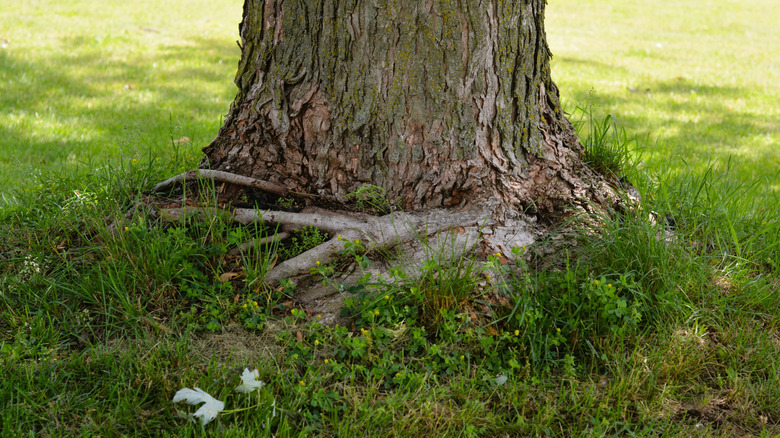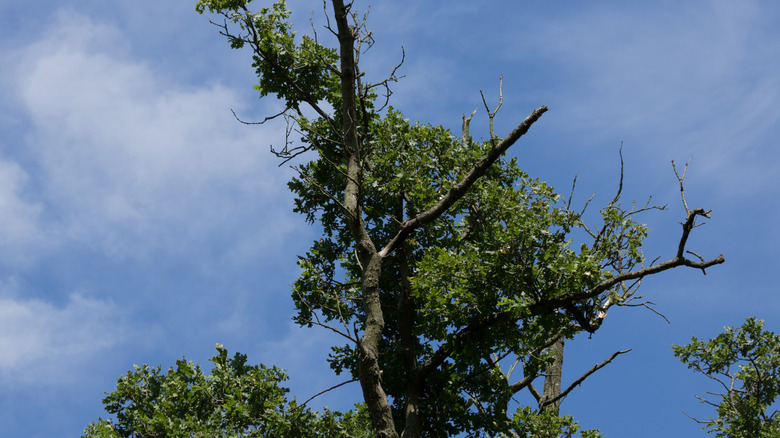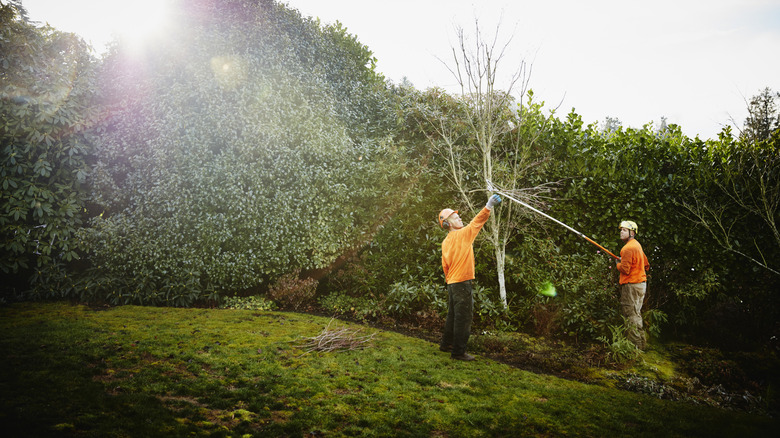Signs Of Tree Root Damage From Frozen Soil
Winter can be an anxiety-inducing season for those with trees in their yard, as super-low temperatures threaten the health of trees' roots. When temperatures drop below freezing, the soil freezes right along with it. Roots within the soil are then susceptible to damage. If you have trees, it's important to know what this damage looks like so that you can act fast and avoid removing the tree from your yard entirely. While speaking exclusively to House Digest, Bryan Clayton, CEO of GreenPal, shared a few signs of tree root damage from frozen soil. If you notice delayed or weak leaf growth, dieback in the tree's canopy, leaning or instability, and cracks or lifting soil around the base of the tree, frozen soil may be the culprit.
Clayton stressed the importance of tackling this problem as soon as possible with the help of a professional. "I can tell you—trees are a lot tougher than people think," he said. "But if you've got one over 25 years old, that's an asset you can't easily replace, so if you suspect root damage from frozen soil, it's worth bringing in a professional arborist." Using Clayton's advice to help you identify root damage, you will have a lot less to worry about each winter.
Look for canopy damage, weak growth, leaning, and cracks in the soil
While speaking exclusively to House Digest, Clayton further detailed each of the signs of tree root damage from frozen soil. Late and poor leaf growth is something to be concerned about. "If spring rolls around and your tree is slow to bud or has sparse, stunted leaves, that's a red flag," Clayton shared. A similar sign of winter injury is dieback in the tree's canopy. "Dead or bare branches at the top mean the roots aren't pulling in enough water and nutrients," the expert said of this damage.
Leaning or instability could also signal that root damage has occurred. "If the tree looks like it's shifting or leaning more than before, frozen soil could have damaged the roots holding it in place," Clayton warned. Even if your tree isn't leaning, inspect the soil around it for another sign of root damage. If the ground appears to be heaving or is splitting at the base of the trunk, it indicates that freezing soil has stressed its roots.
After noticing any of these signs, your next step is to take action to save your tree. According to Clayton, you can water deeply at the roots to rehydrate them as the weather warms up. Additionally, compost or mulch should be applied to the base of the tree to feed it. Our expert shared that he uses shredded pine bark mulch, which is available in most garden centers. Your final action is to refrain from pruning your tree until it has fully recovered.
How to prevent damage and when to hire an arborist
Preventing frozen soil around the base of your tree ahead of the winter months will help you avoid finding signs of root damage in the first place. Luckily, Clayton explained exactly how to do this. Mulch is one prevention tool the expert recommends. "A good 2-4 inch layer of mulch around the base (but not up against the trunk) helps regulate soil temps and prevent deep freezes," he shared while speaking exclusively to House Digest.
The GreenPal CEO also advises watering your roots before a hard freeze – You shouldn't rely on your sprinkler system to water your trees. This is preventative because dry roots are stressed and more vulnerable to damage. "Give your tree a deep soak before winter really sets in," he added. Road salt can also stress tree roots, which are often already struggling to make it through winter as is. Avoid throwing shoveled snow on your lawn or near any plant life.
The final piece of advice Clayton shared is knowing when it's time to call an arborist for professional help. An arborist will need to come in if your tree is over 25 years old, leaning, or if there's lots of dieback in the canopy come springtime. "A mature tree is worth thousands in property value and shade—don't wait until it's too late," Clayton added.


